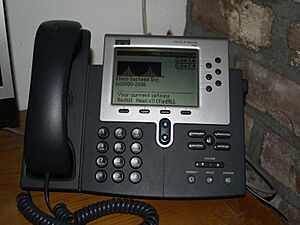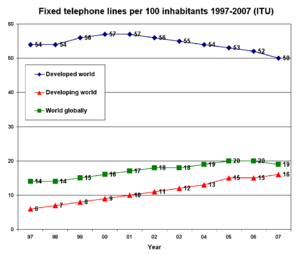Telephony facts for kids
Telephony is all about the technology that lets us send voices, faxes, or other information over long distances. It's like the science behind how your phone calls work! The story of telephony is closely tied to how the telephone was invented and improved over time.
This field often refers to building and using telephones and their systems. It also includes computer hardware, software, and networks that do what old telephone equipment used to do. When computers are involved, it's often called Internet telephony or Voice over Internet Protocol (VoIP).
Contents
How Telephones Started
The very first telephones were connected directly to each other, one pair at a time. Imagine having a separate phone for every person you wanted to call! This quickly became too complicated.
The invention of the telephone exchange solved this problem. An exchange is like a central hub where all telephones in an area connect. This allowed people to call anyone else connected to that exchange. Each phone was linked to the exchange by a wire, called a local loop. Different exchanges were connected by larger trunk lines, letting calls travel even further.
At first, people called "switchboard operators" to connect their calls. When you turned a handle on your phone, a light would flash at the operator's board. The operator would then plug in their headset and ask who you wanted to call. You'd tell them the name or number, and they would connect your call by plugging in wires on the board.
Until the 1970s, most phones were permanently wired into homes. Later, telephone plugs and jacks became common. This made it easy to move phones around the house or swap them out. All the wires from the jacks connect to a main wire that goes from your building to a larger cable. These cables bring many wires from a whole neighborhood to a central telephone exchange.
When you dial a number, equipment at the exchange checks it. It then connects your phone line to another line in the same area or to a trunk line going to a faraway exchange. Most exchanges worldwide are linked together, forming a huge network called the public switched telephone network (PSTN).
In the second half of the 1900s, fax machines and data (like computer information) started using the phone network. Later, parts of the network were updated with technologies like ISDN and DSL to handle this data even better.
Today, telephony uses digital technology for phone services. This means calls can be sent as digital signals, which has made communication cheaper and improved voice quality. One early digital system, ISDN, allowed fast data transfer over phone lines. However, the Internet later became even more popular for digital services.
Since the 1980s, computer telephony integration (CTI) has brought more advanced phone services controlled by computers. This includes making and receiving calls, using phone directories, and seeing caller ID. It's a big part of how modern offices work. For example, when you call a business, CTI helps direct your call to the right department. It also lets you use your computer to make and manage phone calls.
Digital Phone Systems
Digital telephony means using digital electronics to run phone systems and services. Since the late 1900s, the main parts of phone networks have switched from old analog transmission systems to new digital ones. Many of the connections to homes have also become digital.
After the invention of the transistor in 1947, phone networks slowly moved towards using solid-state electronics and automation. With computer-based electronic switching systems that use pulse-code modulation (PCM), the public switched telephone network (PSTN) gradually started sending both signals and voices as digital information. Digital telephony has greatly improved the network's capacity, quality, and cost. It allows for clearer voice calls and more information to be sent at once.
How Digital Telephony Grew
The first analog phone networks started upgrading to digital systems in the early 1960s. These systems took analog voice signals, sampled them, and turned them into digital code using pulse-code modulation (PCM). Early digital systems were expensive and not very good.
Practical digital telecommunication became possible with the invention of the metal–oxide–semiconductor field-effect transistor (MOSFET). This led to the quick spread of PCM digital telephony. In the 1970s, engineers developed MOS mixed-signal integrated circuits, which could handle both analog and digital signals on one chip. These chips led to better analog-to-digital converter (ADC) and DAC chips, which turn voices into digital signals and back again.
By the 1990s, phone networks like the PSTN were mostly digital. They used tiny very-large-scale integration (VLSI) CMOS PCM chips. These chips were used in many places, including telephone exchanges, private branch exchanges (PBX) for businesses, modems, cordless telephones, and cell phones. The speed of digital networks has grown incredibly fast, thanks to the shrinking size of MOS technology.
Sending uncompressed digital audio needed a lot of network bandwidth, which was a problem for early digital networks. So, scientists developed ways to compress audio data. One important method was linear predictive coding (LPC), invented in 1966. It could compress voice data a lot, making real-time conversations over digital networks possible in the 1970s. Another method, the modified discrete cosine transform (MDCT), is now widely used for voice calls over the Internet (VoIP).
New ways of sending information, like SONET and fiber optic cables, further improved digital transmission. Digital transmission is cheaper and allows more calls to be sent at once than old analog systems. Today, your phone might still use analog signals, but these signals are usually turned into digital signals very close to your home.
Internet Phones (IP Telephony)
The world of phone technology has grown a lot with new ways to communicate. Now, telephony also includes Internet services and mobile communication, even video conferencing.
New technologies based on Internet Protocol (IP) are often called voice over IP (VoIP) telephony, or simply IP telephony or Internet telephony. Unlike traditional phone services, IP telephony is not as strictly controlled by governments.
IP telephony uses the same digital network technology that the Internet is built on. It lets you make, send, and receive phone calls over computer networks. VoIP is changing how people make calls and is quickly replacing older phone systems. By 2005, many people in Japan and South Korea had already switched to this digital phone service.
A big step forward in mobile telephony is using IP technologies in mobile networks, like Voice over LTE (VoLTE) and Voice over 5G (Vo5G). These technologies send voice calls over the same Internet-based systems used for data. This means better call quality and faster connections than older mobile networks. VoLTE and Vo5G are becoming the standard for mobile voice calls as phone companies move to all-IP networks.
IP telephony uses an Internet connection and special hardware IP phones, adapters, or computer programs (called softphones) to send conversations as data packets. While it's often used over Wi-Fi, it also works on private networks and other Internet connections.
How Phones Change How We Connect
When we talk face-to-face, we use many non-verbal cues, like facial expressions, body language, and tone of voice. Traditional phone calls don't let us see these cues. Video telephony helps bring some of these back.
The "Social Context Cues Theory" looks at how different types of communication keep these non-verbal cues. It examines things like physical setting, facial expressions, body movements, and tone of voice.
When we use a phone, we lose some communication cues. We can't see body movements or sense touch or smell. However, phones are very efficient for certain tasks, especially in workplaces. Sometimes, a phone call is more useful than a face-to-face meeting.
Mobile phones have changed how we connect even more. Using instant messaging, like "texting," on mobile phones has created a sense of community. Some research suggests that every phone call and text message is more than just talking. It's a way to keep up social connections with family and friends. Even though some cues are lost, mobile phones bring new ways to express things that different groups understand. New words and emojis try to make up for the lack of physical interaction.
Another idea about how we use media is the "Media Dependency Theory." This theory says that people use media or resources to reach certain goals. It links the media, the audience, and the larger social system. Phones, depending on the person, help achieve goals like getting information, staying in touch with others, sending quick messages, or even for entertainment.
See also
- Extended area service
- History of the telephone
- Invention of the telephone
- List of telephony terminology
- Stimulus protocol



